

Are you looking for a spiritual, cultural and historical destination in Saigon? Do you want to explore an ancient temple, with many traces of time and people? Join BDATrip to learn about Giac Lam Pagoda, from its history, architecture, to its activities and dining options. We hope you will have an enjoyable and meaningful trip at this ancient temple.
Located at 565 Lac Long Quan, Tan Binh District, Ho Chi Minh City, Giac Lam Pagoda - also known as Giac Lam Ancestral Temple - is a sacred and accessible destination from the central districts. Here, visitors can choose from many types of transportation such as motorbikes, cars, buses, taxis, or Grab.
The opening hours of the pagoda are from 7:00 to 21:00 every day, allowing visitors to visit at any time. To avoid traffic jams, visitors should avoid peak hours and choose cool times such as early morning or evening.
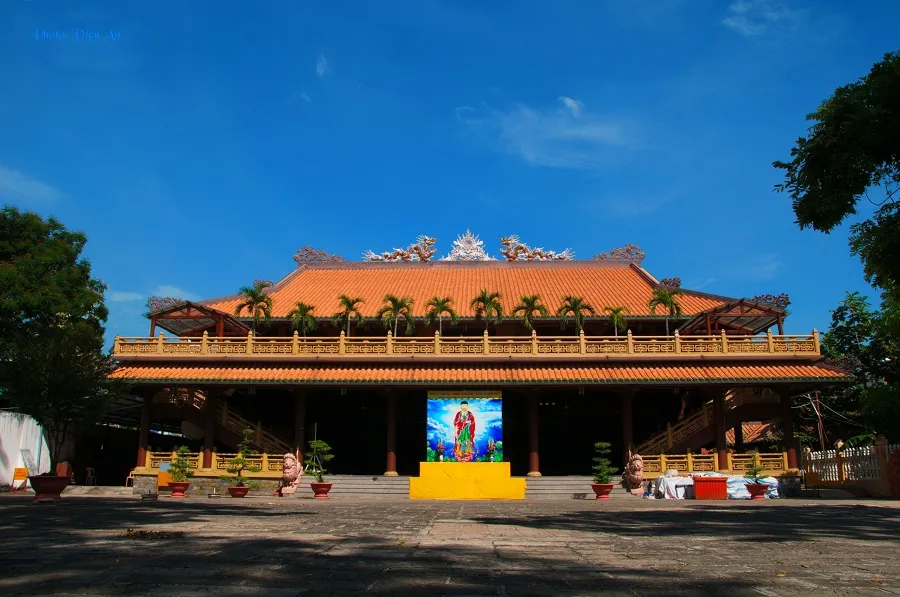
You can get to the pagoda by many means such as:
- Motorbike: A flexible, fast choice, you can easily find the way through the map or ask the local people. There is a parking service with a price from 5,000 VND to 10,000 VND.
- Car: A safe, comfortable means, suitable for groups or families. There is a parking lot near the pagoda with a price from 10,000 VND to 20,000 VND.
- Bus: Economical, environmentally friendly, suitable for those who are not in a hurry. The suggested bus routes are: number 3, number 4, number 27, number 65. The bus fare is 6,000 VND.
- Taxi/Grab: Easy, convenient, suitable for those who are not familiar with the road or do not have their own vehicles. The fare depends on the distance and travel time, usually from 50,000 VND to 200,000 VND.
Giac Lam Pagoda, a sacred symbol with a history of more than 300 years, witnessed the ups and downs of Vietnam’s history. It was built in the spring of 1744 by Ly Thuy Long, originally a Minh Huong person, the pagoda was initially named Son Can and later known by names such as Cam Son and Cam Dem, under the reign of King Nguyen Phuc Khoat.
In 1774, Zen master Phat Y Linh Nhac, sent his disciple Zen master To Tong Vien Quang to become the abbot and changed the name of the pagoda to Giac Lam. Under the leadership of Vien Quang, the pagoda became famous as a center for training scriptures and precepts for monks in Gia Dinh and the whole South.
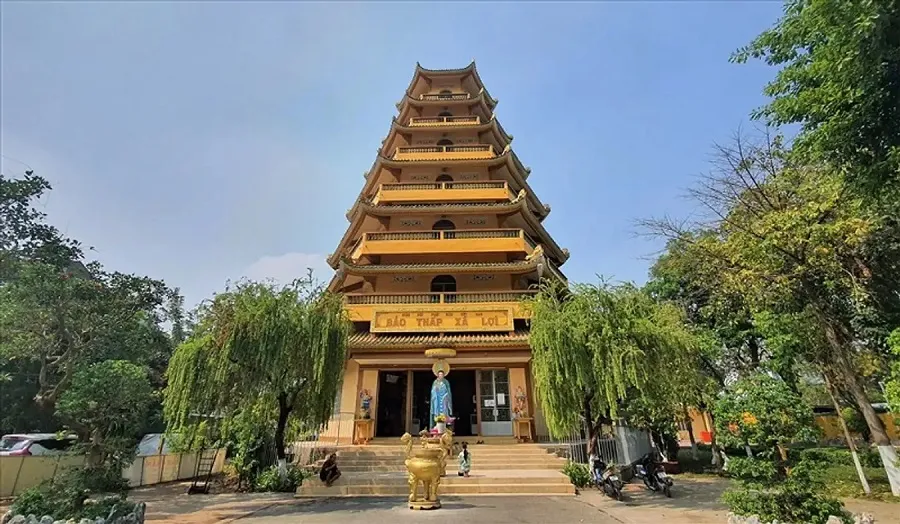
By 1873, under the management of Zen master Minh Khiem, pagoda also became a place for printing and copying scriptures, as well as a place for carving wooden blocks of scriptures, laws and translating Nôm works of Buddhism. The scholar Trinh Hoai Duc once described the pagoda in his work “Gia Dinh Thanh Thong Chi”, with a charming landscape: green trees, flowers blooming brightly, clouds drifting, creating a quiet and poetic space.
During the resistance war against France and the US, the pagoda was also a hiding place for many famous revolutionary activists such as Nguyen Thi Minh Khai, Ho Chi Minh, Vo Nguyen Giap, Pham Van Dong, Ton Duc Thang. In 1953, the pagoda received a bodhi tree and a gem relic of the Buddha from Sri Lanka, which was placed at Long Van Pagoda.
In 1988, the pagoda was recognized as a national historical and cultural relic. Today, Giac Lam Pagoda is still a spiritual, cultural and historical destination that attracts many visitors from home and abroad.
Giac Lam Pagoda, an architectural masterpiece, reflects the “Tam” style characteristic of the pagodas in the South. This pagoda consists of three main rows of houses: the main hall, the lecture hall and the monk’s house, each with its own meaning and purpose.
Notably, the three-gate gate - an extension added in 1955 - features a three-door architecture with four characters “Giac Lam Tu” carved on top, written in Chinese. The roof of the pagoda is designed with four flaps, creating a unique and harmonious image.
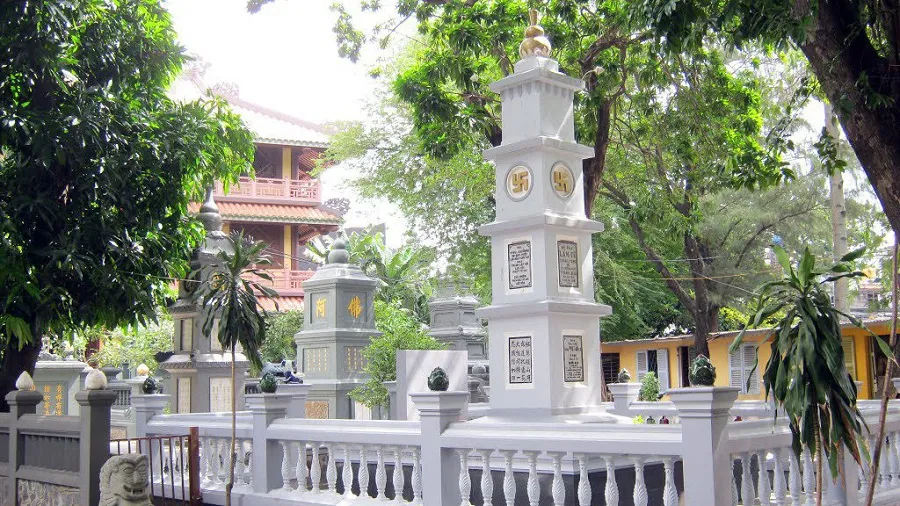
The main hall, the heart of the pagoda, stands out with its cake-shaped roof and unique decoration. Four large wooden columns with the words “Buddhist Ly Thuy Long donated money to build” affirm the origin of the pagoda. Inside, there is a hand-embroidered painting of Amitabha Buddha from the early 20th century, along with the altar and important Buddhist symbols.
The lecture hall, the space for teaching and organizing festivals, also follows the cake-shaped roof and exquisite decoration. Here, there are four wooden columns carved with the words “Buddhist Nguyen Van Tai donated money to build”, and a hand-embroidered painting of Avalokitesvara from the same period, creating a solemn and dignified space. The monk’s house is not only the residence of the monks but also preserves the carved wooden blocks of scriptures, laws and Buddhist documents. The architecture and decoration of this place also follow the traditional style, with large wooden columns and a hand-embroidered painting of Maitreya Buddha from the early 20th century, carrying artistic and spiritual values.
In addition to these works, pagoda also has a stupa, a bell tower, a bronze tower, a stele house, a monk’s house, a guest house, a dining room, and a toilet. Each work is designed in a traditional architectural style, creating a harmonious and meaningful spiritual complex, reflecting the subtle combination of culture and belief, creating the unique and distinctive beauty of pagoda.
The gate of the second gate stands solemnly at the main entrance of pagoda on Lac Long Quan Street, not only as a door to the sacred space but also as a symbol of the ancient and solemn. Two 7-meter-high ironwood columns with a diameter of 0.8 meters are sturdy and majestic, supporting the gate. A special highlight on the top of the column is two dragons carved meticulously and delicately, curling lively as if swimming in the air.

The red-tiled roof, bringing a traditional and aesthetic beauty. The four characters “Giac Lam Tu” carved in Chinese on the roof of the gate not only affirm the identity of the pagoda but also express the respect and gratitude for the Buddhist tradition.
The three-gate gate, an important part of the pagoda complex, serves as a secondary gate opening to the inner spiritual space. Built in 1955, the three-gate gate stands out with three doors and on top are four characters “Giac Lam Tu” like an invitation, carved in traditional Chinese.
The architecture of Giac Lam Pagoda impresses with its cake-shaped roof, a characteristic element of the Southern style. This roof has a special shape with a circle, bulging in the middle and tapering at both ends, creating an image that is both soft and strong. The richness in patterns and motifs adds to the beauty and artistry of the roof.
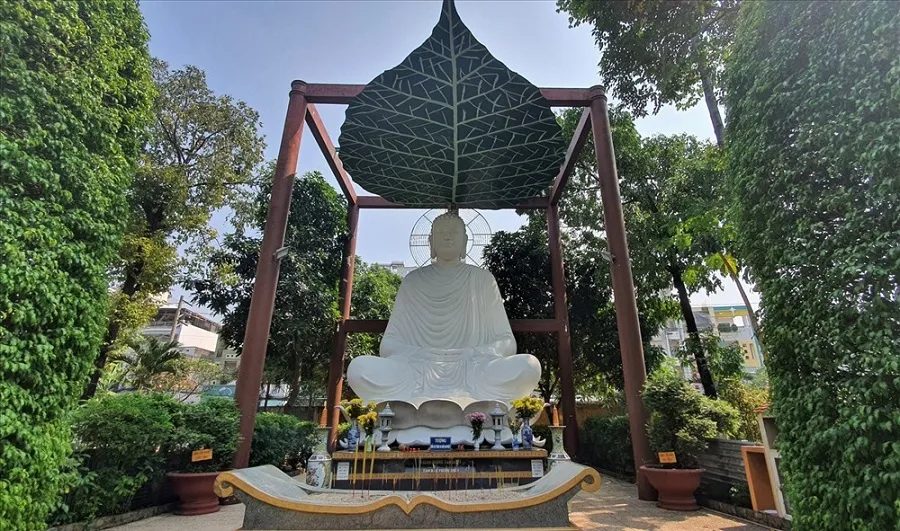
The origin of the cake-shaped roof is said to originate from India, then spread to Vietnam through Cambodia. Not only an architectural symbol, the cake-shaped roof also carries a profound meaning of the eternity, immortality and vastness of the Buddha’s law, reflecting the philosophy and deep spirituality of Buddhism.
The main hall, the solemn focal point of pagoda, stands out with its cake-shaped roof rich in patterns and motifs. This place contains four sturdy wooden columns, carved with the words “Buddhist Ly Thuy Long donated money to build” - a valuable historical mark. The wall behind the main hall displays a hand-embroidered painting of Amitabha Buddha, an artistic work with every carved stroke from 1909 to 1910, showing skill and dedication.
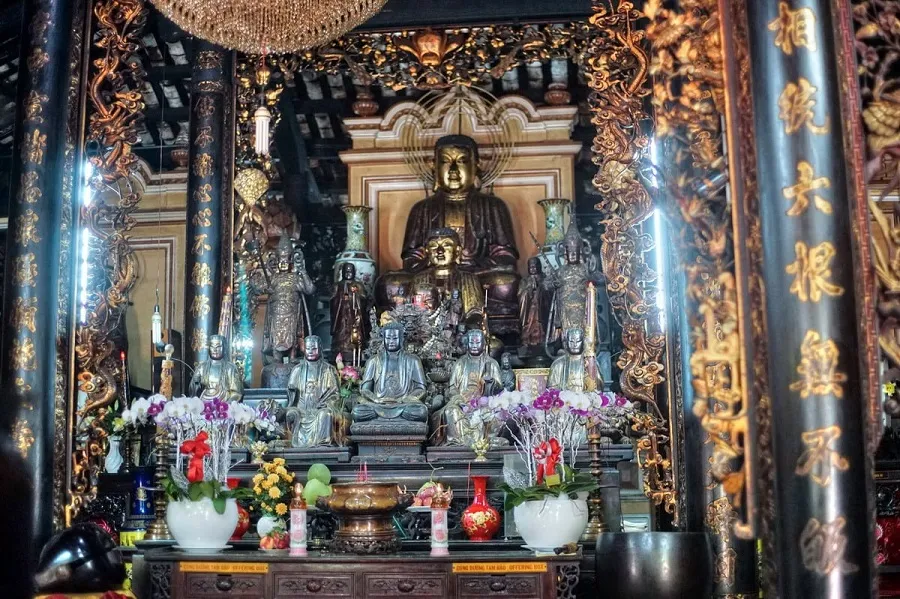
In front of this painting is the altar of Amitabha Buddha, with the solemn presence of a gem relic of the Buddha, a sacred treasure received from Sri Lanka in 1953. In addition, two altars of Sakyamuni Buddha and Maitreya Buddha are placed splendidly, creating a spiritual ensemble full of meaning and solemnity.
Behind the main hall of Giac Lam Pagoda, a large area, filled with greenery, creating a cool and peaceful space, is where the prominent works are located, such as:
- Stupa: 32 meters high with 7 floors, the tower was built in 1993. This place has preserved a precious gem relic of the Buddha from Sri Lanka since 1953. The Indian architecture of the tower, with exquisite patterns and carvings, creates a sacred work, worshiping the Buddha and Bodhisattvas.
- Bell tower: A 18-meter-high, 3-story building, built in 1999. Inside is a giant bronze bell weighing 1.5 tons, cast in 1993, decorated with Chinese characters and motifs. The bell rings to signal the rituals and mealtimes of the monks.
- Bronze tower: Also 18 meters high and 3 floors, this tower was completed in 1999. Inside is a modern electronic clock, displaying time, date, year and temperature, showing the combination of tradition and modernity.
- Stele house: A small building with a red-tiled roof, built in 1999. Inside the house is a stone stele 2.5 meters high, 1.5 meters wide, carved with Chinese characters and motifs, recording the history of building and repairing the pagoda from 1744 to 1999.
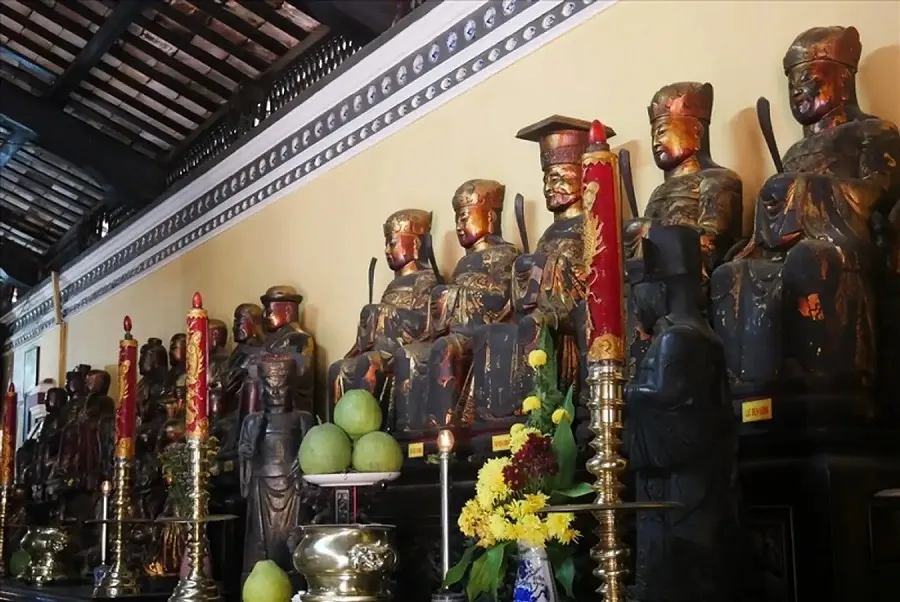
When visiting pagoda, in addition to admiring the ancient and profound architecture and history, you also have the opportunity to participate in many meaningful activities:
- Practice spiritual rituals: You can light incense, pray, and pray for yourself and your family. Incense, candles, flowers and fruits can be bought at the stalls around the pagoda or brought from home. Lighting incense at important points such as the second gate, the main hall, the lecture hall and the stupa is a sacred experience. Remember to bow and thank at each place you light incense.
- Participate in spiritual activities: The lectures, preaching, meditation, and recitation of the Buddha organized by the monks and monks are great opportunities to deepen your soul. Information about the schedule can be found at the information desk, website or fanpage of the pagoda. When participating, wear modest clothing, strictly follow the rules and instructions of the pagoda.
- Enjoy vegetarian cuisine: Trying delicious and nutritious vegetarian dishes served by the pagoda is an experience not to be missed. You can enjoy it for free or contribute as you wish at the pagoda’s dining room, or buy vegetarian dishes from the stalls. Eat and drink with culture, avoid waste and maintain hygiene.
- Shopping for Buddhist items and souvenirs: The stalls around the pagoda offer many types of Buddhist items, worship items, books, CDs, movies, and souvenirs. You can find unique and quality products at reasonable prices. When shopping, do it with awareness, avoid buying fake goods or bargaining too much.

To fully enjoy the beauty and spiritual meaning of Giac Lam Pagoda, you can attend the following special events:
- Pagoda Festival: Held on the 15th of the first lunar month every year, this is one of the biggest and most exciting events of the pagoda. The festival is diverse with many cultural and religious activities such as opening the seal, praying, praying for the dead, offering, distributing fortune, and giving gifts. Participating in this festival, you have the opportunity to wish for a new year full of peace, prosperity and happiness.
- Vu Lan Festival: Taking place on the full moon of the seventh lunar month, Vu Lan is an important occasion to express gratitude and filial piety to parents and ancestors. Attending this ceremony, you can pray for the salvation and peace of your relatives, show your gratitude and gratitude.
- Buddha’s Birthday: Commemorated on the 15th of the fourth lunar month every year, Buddha’s Birthday honors the birth, enlightenment and nirvana of Sakyamuni Buddha. This is an opportunity for you to respect the Buddha, learn the Buddhist teachings and pray for peace and happiness for the world.
- Tet Nguyen Tieu: Held on the full moon of the first lunar month, this is an occasion to ask for the protection of the Bodhisattvas, wish for a new year full of luck and goodness, overcome all difficulties and challenges. Participating in Tet Nguyen Tieu, you can show your respect and gratitude, and pray for the well-being and happiness of yourself and your family.
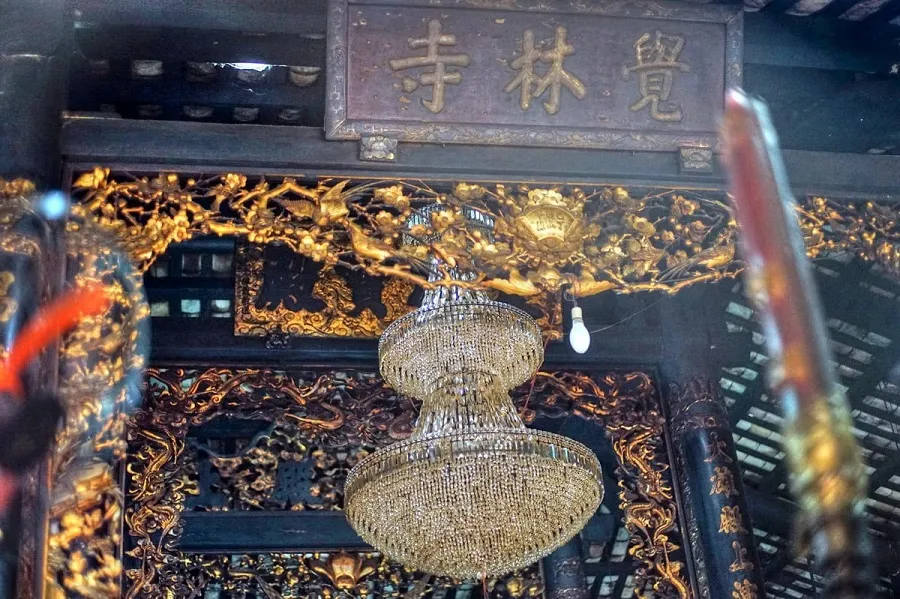
Pagoda welcomes visitors all year round, but to fully enjoy the sacredness and beauty of this place, you should consider the following times:
- Holidays and festivals: This is an ideal opportunity for you to immerse yourself in the lively and warm atmosphere of the Buddhist community. Participating in rituals such as offering, distributing fortune, and giving gifts, you not only receive blessings but also feel the connection of the community. However, be prepared for the crowds and bustle on these occasions.
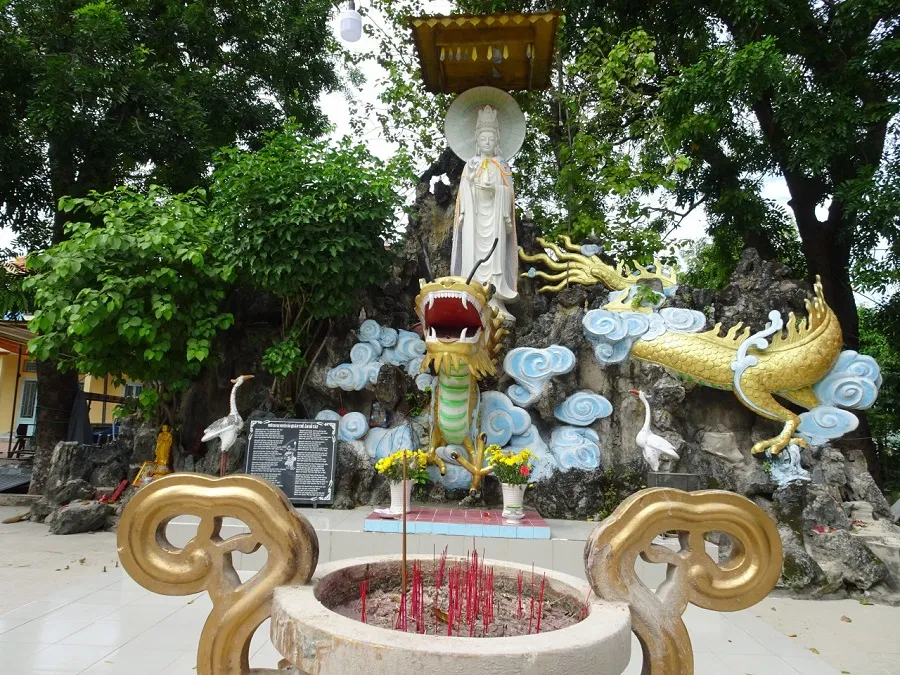
- Full moon and first day of the month: These days are suitable for attending lectures, preaching, meditation, chanting and reciting the Buddha by the monks and monks. It is also a good time to light incense, pray for yourself and your family, bringing a feeling of purity, peace and happiness.
- Weekdays: This is the ideal time to admire the ancient and profound architecture and history of the pagoda and enjoy vegetarian cuisine. Shopping for Buddhist items, worship items, souvenirs and books at the stalls around the pagoda is also a valuable experience. Coming to the pagoda on weekdays, you will find peace, comfort and relaxation, away from the hustle and bustle outside.
Visiting Giac Lam Pagoda, you not only admire the attractive architecture and history but also have the opportunity to enjoy delicious and nutritious vegetarian dishes, reflecting the spirit of Buddhism such as:
- Vegetarian rice at the pagoda: This is an experience not to be missed when visiting pagoda. Enjoying vegetarian rice at the pagoda’s dining room, you will get to try traditional vegetarian dishes such as rice, soup, vegetables, beans and mushrooms. This is also an opportunity to interact with the monks, nuns and Buddhists, bringing a meaningful culinary experience. Eat and drink in a civilized and respectful manner.
- Vegetarian restaurants around the pagoda: If you want to explore more vegetarian flavors, you can visit the vegetarian restaurants near the pagoda. Each restaurant offers a variety of vegetarian dishes such as vegetarian beef noodles, vegetarian pancakes, vegetarian bread, and more with reasonable prices from 20,000 VND to 50,000 VND per serving.
- Snacks Near the Pagoda: If you want to go light with snacks, the stalls around the pagoda serve a variety of delicious dishes such as mixed rice paper, grilled rice paper, flan, buns, tea and ice cream. Reasonable prices, ranging from 5,000 VND to 20,000 VND per serving, ensure you will find your favorite snack. Some popular snack shops include Co Ba mixed rice paper, Co Tu grilled rice paper, Co Nam flan, and Co Bay tea.
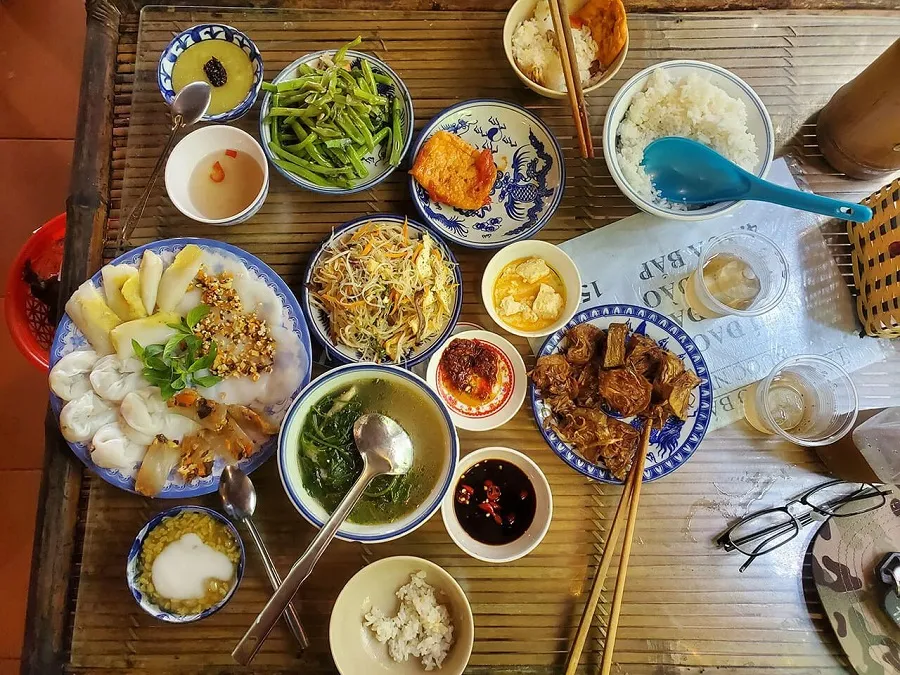
When visiting pagoda, you should pay attention to the following things to have a complete and respectful cultural and spiritual visit:
- Dress politely, modestly, not too flashy.
- You should leave your shoes outside the gate or at the available shoe racks, and also pay attention to your shoes, to avoid confusion or theft.
- Do not talk loudly, laugh, run, or joke in the pagoda.
- Do not take pictures, film in the pagoda without the permission of the pagoda management board.
- Do not eat, smoke, chew gum in the pagoda.
- Do not touch the worship items, paintings, Buddha statues, stone steles, wood-carved scriptures… in the pagoda to avoid damaging or losing these items.
- Do not bring pets, weapons, explosives, banned substances, dirty, smelly… into the pagoda to avoid causing trouble or danger for yourself and others.
Giac Lam Pagoda is one of the most ancient, historical and sacred pagodas in Ho Chi Minh City. Hopefully this article will help you have more useful information when visiting the pagoda.
Some attractive tourist destinations in the city. Ho Chi Minh:
Copyright © 2022 BDATrip.com | All rights reserved.